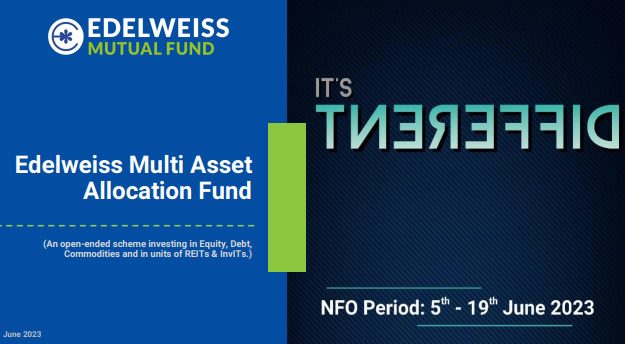Edelweiss launched Edelweiss Multi Asset Allocation Fund mainly to target those who are eager to save tax from their debt side of the portfolio. AMC claims that it is DIFFERENT. What is different here? Whether one should invest in this fund just for the sake of tax saving and what are the risks involved here?

It is an open-ended scheme investing in Equity, Debt, Commodities, and units of REITs & InvITs. The asset allocation specified by the fund document is as below.
# 35% to 40% in equity arbitrage. This is mainly kept to take advantage of debt fund indexation benefits. As you may be aware that effective from 1st April 2023, the debt fund taxation rules changed. I have explained the same in detail in my earlier post “Debt Mutual Funds Taxation from 1st April 2023“. Do remember that the fund will not have a direct exposure to equity but an exposure to equity cash future. It is mentioned that the exposure may be in the range bound of 10% to 80%. However, I am sure that they will not go below 35% to make sure that the fund attracts the debt fund indexation benefit.
# 10% to 15% in gold and silver arbitrage. The fund claims that it 100% hedged Gold and Silver using an arbitrage strategy. The fund will not have any open exposure to gold and silver directly. The allocation may be in the range bound of 10% to 30%.
# 45% to 55% in fixed income of 1-3 years Maculary duration. The portfolio consists of G-Sec, SDL, and AAA-rated corporate bonds. It is mentioned that the exposure may be in the range bound of 10% to 80%.
# 0% to 10% in units issued by REITs and InvITs.
Edelweiss Multi Asset Allocation Fund – Should you invest?
If you look closely, the fund is targeting those investors who are eager to avail the indexation benefit from their debt portfolio. Hence, in my view, the fund’s equity arbitrage allocation will never go below 35%. Hence, the remaining 65% can be between gold and silver arbitrage and fixed income (or REITs and InvITs).
However, you look at the benchmark they set – Nifty 500 TRI (40%) + Nifty 5 yr Benchmark G-Sec Index (50%) + Domestic Gold Prices (5%) + Domestic Silver Prices (5%).
If the assets are changing, then accordingly the benchmark % for each asset class must also change to truly reflect the fund performance over the benchmark. However, in this case, there are no such range-bound benchmark changes specified. Instead, AMC fixed the asset allocation for respective benchmarks.
Let us try to discuss one by one the asset classes which this fund is offering us.
- Equity Arbitrage – I am unsure of why the fund is benchmarked to Nifty 500 TRI when the position is not direct equity but just an arbitrage. Instead, the fund MUST be benchmarked to an arbitrage index like the Nifty 50 Arbitrage Index (just an example). A simple arbitrage fund is enough for you to generate this return.
- Gold and Silver Arbitrage – If you look at the product presentation, they showed a chart of 3 years rolling returns for Silver Arbitrage (where AMC claim, the data is available from Silver Arbitrage since 2015). Gold data is MISSING HERE. In fact, for a common man, it is hard to find past gold and silver arbitrage performance data and it is completely a new blind belief for investors to assume that this part of the fund will perform better. Again gold and silver are highly volatile assets (more than equity), which I have proved in my earlier various posts “Nifty 50 Vs Gold – Which is the best investment?“, “Sovereign Gold Bond Returns – How much can you expect?“, “Gold Volatility – Based on 43 Years of History“, and “Gold Price of Rs.18.75 in 1925 to Rs.47000 in 2020 – Should you invest?“. Considering all these aspects, we are unknown of the reward compared to the risk we are taking in this part of the fund.
- Fixed Income – Even though the fund invests in Gsec, SDL, and AAA-rated bonds, look at the Macaulay duration. It is mentioned as 1-3 years. But the AMC claims that it is ideal for more than 3 years of investors. The Macaulay Duration is a measure of how long it will take for you to recoup your investment. Hence, if the fund is claiming that Macaulay’s duration is within 1-3 years, then never invest and hold it for 3 years. Because if there is volatility after a year or so, then it will take around 1-3 years of time to recoup the investment. Hence, you have to look for a time horizon of at least more than 6 years holding period but not lesser than that. Again, I am unsure of the benchmark here. The fund benchmarked to the Nifty 5 yr Benchmark G-Sec Index but the fund is holding SDL and AAA-rated bonds too.
Considering all these factors, I feel that the fund is launched with the intention to attract debt fund investors who are eager to save the tax due to indexation benefits. If you are so much concerned about taxation and your goals are short-term in nature, then use an arbitrage fund. Otherwise, use FDs, Ultra Short Duration Funds, or Money Market Funds.
Note – This post is only for information purposes. It must not be construed as investment advice.


